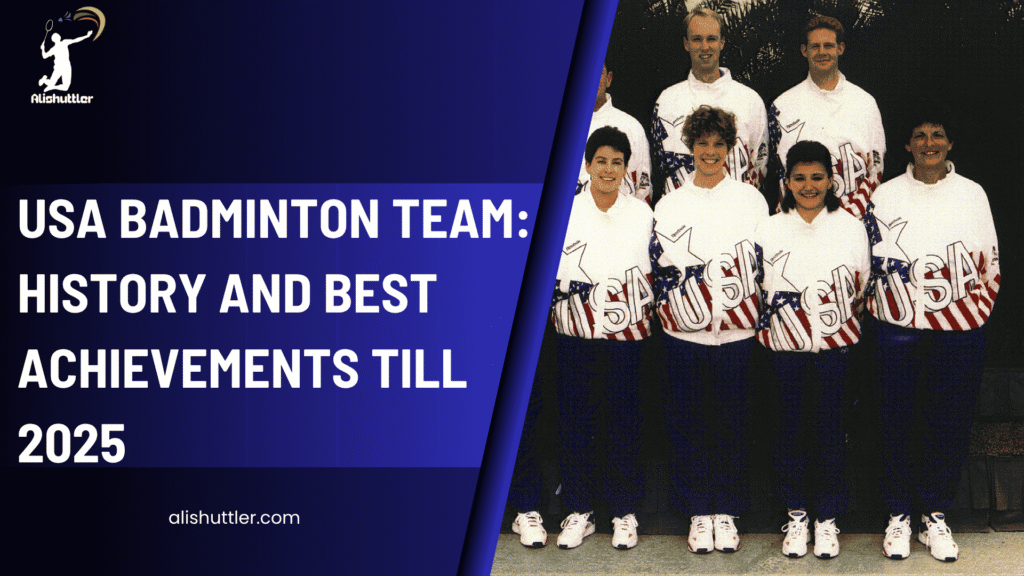USA Badminton Team, the national team that represents the United States in world badminton competitions. The team participates in events such as the Olympics, World Championships, and Pan American Games.
Players hail from clubs and training centers throughout the nation and frequently begin in youth circuits. The team trains with coaches and support staff to develop hard skills.

Next, find out how the team is selected and what the training is like.
National Team Structure
The USA national badminton team is managed by USA Badminton, the sport’s national governing body in the United States. This organization governs the regulations, development and day-to-day management of the sport. Players from various states represent a broad blend of backgrounds and playing styles.
A support network of coaches, fitness trainers and medical staff worked with the athletes. Coaches steer practices, assist with skills, and strategize for tournaments, whereas support staff tend to nutrition, mental wellness, and injury management. The team capitalizes on specialized training hubs, such as the Badminton Performance Center in California, where elite players receive state-of-the-art training equipment and coaching.
The team chooses athletes through a clear, multi-step process:
- Watch performances at top national tournaments.
- Review results from international events.
- Check player fitness and readiness.
- Get recommendations from coaches.
- Hold tryouts or camps for final picks.
World-class facilities keep players razor-sharp. They train in gyms with courts, weight rooms and space for recovery. Resources contain video tools for match review and data tracking.
Olympic Team
The Olympic badminton squad is particularly valuable as it represents the nation’s elite on a worldwide platform. These players have to fulfill established qualifications – world rankings, results at sanctioned events and criteria from USA Badminton and the IOC.
Take, for example, the national team structure — players have to play a minimum number of international tournaments and achieve a world ranking sufficient to be eligible. Previous Olympic teams had difficult draws, frequently running into world giants too soon, but every showing brings additional exposure to the game.
Howard Bach and Eva Lee just to name a few. They establish standards for others and motivate newcomers.
Pan Am Team
The Pan American team is crucial in competitions throughout North and South America. It’s a primary avenue for players to acquire crucial experience in big matches. Including golds and podium sweeps in doubles and mixed, Team USA has won medals at the Pan Am Games.
Athletes are selected from regional and national competition results. The Pan Am Games are important for the sport’s development, providing young players an opportunity to challenge themselves and gain experience from their elder counterparts.
Such contests increase the team’s depth and contribute to the foundation of a world-level player pool in the future.
World Championship Squads
For world championships, the USA sends teams for singles, doubles and mixed. Teams are selected by form and world results. The USA’s pedigree in these competitions boasts a 1952 Thomas Cup runner-up position and a top-20 Sudirman Cup placing.
Shuttlers such as Tony Gunawan and Beiwen Zhang have spearheaded the efforts over the past few years, going deep and garnering admiration. International play not only pushes the team to up their game, but it brings new skills back home.
This has assisted the sport in prospering and amassing an increased fan base in the US.
Key Players
USA badminton team boasts a blend of veteran stars and new blood. These players have elevated the nation’s status in the game, competing in international tournaments and igniting a fresh enthusiasm for badminton. Their talent, drive and leadership on and off the court are helping to define the future of the sport in the U.S.
1. Current Stars
Howard Shu is a two-time Olympian, representing the USA in 2016 and 2024. His successes on the international stage have made him a regular presence at tournaments. Beiwen Zhang, world no. 9, spearheads the women’s team with her rapid footwork and powerful smash.
Iris Wang, ranked 44th in the world, has shiny net play feet. Kerry Xu, another Olympian, is tactically aware and has played in international competitions. These players practice at elite gyms, frequently with international coaches.
Their schedules blend technical drills, match simulations, and strength training, providing them the foundation required to contend at the top. Their success intrigues young players and raises the visibility of badminton in the US.
2. Rising Talents
Joshua Yuan has impressed on the world scene, wearing the nation’s colors at junior and senior competitions. Then there’s Esther Shi, a world number 182 who is a rising junior. They grow within regimented youth programs, with access to expert coaches, physical therapists and tournaments at home and overseas.
National and regional tournaments provide these stars-to-be a stage to try out their abilities. Competitions such as the Pan Am Junior Championships and U.S. Junior Nationals have served as springboards to their careers. Youth development is still key for the USA squad.
3. Doubles Specialists
Vinson Chiu has notched success in doubles, leveraging sharp court chemistry and quick reflexes to triumph at tournaments such as the Pan Am Championships. Doubles duos in the USA typically emphasize rapid volleys at the net and effective communication, a key element in intense matches.
Doubles training consists of drills that focus on coordination and strategy over speed or brute force. These athletes encounter special challenges, such as requiring almost perfect timing and trust with their partner.
Elite duos like these often invest years cultivating chemistry, a fact reflected in their court results.
4. Singles Contenders
World No. 94 Jennie Gai is a steady hand who can handle pressure. USA’s singles players employ grinding rallies and intelligent shot selection to wear down opponents. Significant victories have occurred at the Pan Am Games and other BWF competitions.
The singles competition is brutally hard — long rallies, mental discipline for each point. Key players hustle for endurance and court coverage.
Player Earnings
Player earnings in USA badminton derive from multiple sources, but the sport overall does not compare with the prize money in basketball or tennis. Most players earn peanuts, particularly those below 32nd. Prize money, sponsorships, coaching, and club leagues all help form the system — and each introduces its own restrictions and potential.
- Prize money from tournaments (national and international)
- Sponsorships and endorsements from sports brands and companies
- Club league match fees and bonuses
- Coaching roles at clubs, schools, or for private clients
- Income from exhibitions or badminton clinics
Prize Money
Prize money for USA badminton players varies by tournament level. International events present the biggest pools. Below is a simplified view:
| Tournament Level | Winner (USD) | Runner-up (USD) | Semifinalist (USD) |
|---|---|---|---|
| BWF Super 1000 | $70,000 | $34,000 | $14,000 |
| BWF Super 750 | $52,500 | $25,500 | $10,500 |
| US National Championships | $5,000 | $2,500 | $1,500 |
Big tournaments like the BWF super series and India’s Premier Badminton League (PBL) offer the biggest earning opportunities. For instance, Lee Cheuk Yiu pocketed $61,000 within only three weeks in the PBL.
The average prize money for #51–100 finishes is a mere $2,053 per year. In contrast, players finishing #33–50 earn between $12,959 and $43,759 for singles. Top 10 players can earn up to $147,600 per year.
Prize money incentivizes athletes to play better, but the chasm between elite players and lower-ranked ones remains vast. Doubles provides less prize money per player than singles, which restricts earnings even more.
Sponsorships
Sponsorships contribute significantly to player incomes. Big names like Yonex, Victor, and Li-Ning do sponsor American players, but the deals are small in comparison to bigger sports with broader audiences.
Players ranked #51–100 could earn nothing or up to $10,000 a year in sponsorships. Those who crack the top 32 or have breakout personalities can bring in more attractive deals.
Marketability, social media savviness, and big tournament results all help in securing these endorsements. Such deals offer a safety net that can be the margin of survival in the sport or opting out for a more secure career.
Coaching Income
Many US badminton players transition into coaching, either part-time or upon retirement. Coaching salaries differ significantly based on experience, success, and location. A coach at a top club or school can make more than one at a smaller club.

There’s a rising demand for qualified coaches, with youth programs and clubs continuing to pop up across the country. This demand allows talented players to stay competitive, earn a living, and share their knowledge, helping the next generation of American players rise.
Financial Challenges
Travel, equipment, and training costs significantly eat into player earnings. Many players have to pay their own way to international events, which can run into the thousands of dollars annually.
The monetary pressure is frequently the reason rising stars abandon the game prematurely. Even top 32 players, who make $3,600-$6,000 more from club matches, rarely approach the security of other professional sports.
Historical Milestones
Badminton in the US has developed over the last 100+ years punctuated by historical milestones that defined the sport and its culture. Each of these milestones reflects the game’s transition from the black courts of elite clubs to international courts, impacting its national presence and popularity.
Early History
Badminton initially took hold in the USA in 1878 when the Badminton Club of New York was established. This club was a huge factor in exposing the game to new fans and encouraging other clubs to form. Initially, pioneers and collectives, such as Boston and Chicago, drove the sport outside of private meetups and into the spotlight, culminating in early local competitions.
Despite its appeal, badminton confronted steep challenges as a sport. It fought for air in a landscape of baseball, basketball and tennis. There were not many dedicated courts and resources, and it was years before national organizations were able to establish consistent tournaments or a standardized rule set.
By the early 20th century, though, the sport took off, with more clubs and an increasing number of players signing on throughout urban centers.
Olympic Appearances
Badminton’s Olympic run with the USA got its start in 1972 when it was a demonstration sport. It wasn’t until 1992 that badminton became a full medal event and America finally sent its first official team. American players, though not medaling, demonstrated the US could compete with the best.
Competing on the stage received more national focus, as players such as Howard Bach and Eva Lee qualified for several Games and went as far as the late rounds, paving the way for younger players to follow. Olympic participation gave the sport more notoriety in the U.S. Motivated a young generation to get involved with badminton.
Still, the team was habitually challenged by Asian and European opposition, and podium finishes were few and far between. These struggles underscored the necessity to further bolster, train and invest in grassroots programs to bridge the divide.
Pan American Dominance
The U.S. Has fared famously well at the Pan Am Games, consistently bringing home medals and frequently sweeping events. Among their most memorable triumphs are the numerous golds they won in singles, doubles and mixed, with the women’s team taking the Uber Cup in 1957 and 1963. These victories established the benchmark for regional superiority.
These accomplishments did much to elevate the sport’s profile back home, drawing greater youth and club-level participation. As recently as 2023, the USA made it to the final of the Pan Am Mixed Team Championships, losing to Canada, demonstrating the team’s ongoing strength.
Lasting Impact
These were the milestones that formed badminton’s destiny in the USA. The sport still grows, courtesy of pioneer clubs, Olympic dreams and local triumphs. Players’ toil still motivating and uniting admirers even now.
The Cultural Divide
Badminton’s place in American culture is defined by different principles and incentives than in countries where the sport is mainstream, like Taiwan. In the US, there’s an emphasis on accomplishment and self-improvement, whereas in Taiwan social recognition and health needs are bigger drivers behind sports. These manifest in how they play, how long they stay engaged, and even what they extract from the game.
Mainstream Perception
A lot of Americans just think of badminton as a backyard activity, something you do at family reunions or summer camp, not an intense competitive sport. This contributes to the myth that badminton is less intense than other racket sports, such as tennis or squash. Its reputation as a backyard pastime caps it as a competitive sport, eclipsing it from gyms and big leagues.
Celebrity involvement can change this perspective. Whenever politicians or celebrities give badminton a shot, whether in Instagram snaps or on-court exhibitions, enthusiasm surges. These boosts tend to be ephemeral unless they’re supported by enduring initiatives or additional press.
Basketball or baseball have stable backing because of leagues, superstar players and consistent national coverage.
Grassroots Growth
At the core of talent development and interest building are grassroots programs. Local clubs, school gyms, and city centers are often the initial havens for youth players. Here in the USA Badminton Team, youth-facing initiatives like afterschool badminton or local tournaments dismantle the ‘USA Badminton Team is just for fun’ concept and demonstrate its competitiveness.
A few former players who began their journey in our community programs are now competing on national or even international stages, demonstrating that early support really does count. Yet, unlike Taiwan where group involvement and public validation are paramount, American programs tend to emphasize individual development and personal achievements.
This focus is a double-edged sword. It motivates certain competitors to thrive but potentially constrains more widespread team participation.
Changing The Narrative
Groups and clubs around the USA strive to renew the USA Badminton Team’s image with awareness campaigns and player development stories. Online platforms are a big factor. Expert badminton rally clips, coaching tips, and tournament highlights now go viral to millions, helping eradicate outdated stereotypes.
Social media provides players an opportunity to display the sport’s speed, skill, and fitness advantages that make it more attractive to new fans. International victories by US athletes contribute. When American players excel overseas it highlights the sport and breaks down the notion that it’s not ‘serious’ or ‘mainstream’.
These moments, when broadcast broadly, can mold public perception and push badminton toward the limelight.
Cultural Differences
US players tend to begin earlier and play later, averaging 31 years behind them, versus 23 in Taiwan. The divide is evident in motivation. USA Badminton Team players value accomplishment, and Taiwanese ones are more prone to pursue social status and tension release.
Use among older adults in both locations cite enjoyment, health, and nimbleness as their primary motivators for playing. However, their ranking shifts between cultures.
Future Outlook
USA Badminton Team is at a crossroads. Young guns like the Xu twins are not just contending for global positions, they’re redefining effort and outcomes. With recent victories over elite pairs and finals appearances, they’re definitely illustrating how US competitiveness is turning around.
This momentum, if met with improved support and intelligent expansion, might allow the USA to catch up to the leaders. Technology and funding, and new programs will all influence the future decade for the USA Badminton Team.
| Trend/Opportunity | Description |
|---|---|
| Youth Development | Rising interest among school-age athletes, especially after high-profile successes |
| Tech Integration | Data analytics, video review, and wearable tech improving training |
| Digital Engagement | Social media and live streaming expanding reach and awareness |
| Club-School Partnerships | New pathways through club and school cooperation, reaching more diverse groups |
| International Networks | More US players training and competing abroad, gaining vital experience |
Development Programs
The USA Badminton Team has junior championships and regional centers for training. These programs identify and nurture young talent from a broad base. Kids begin in community clubs, progressing to national camps if they display potential.
By collaborating, clubs, schools and the national body allows children to enter badminton at various ages and ability levels. It provides your budding sport stars with a defined roadmap, from the school teams to beyond.
In China and Denmark, powerful club-school connections have yielded world-class stars. Their systems employ early talent identification, specialized assistance, and plenty of high-level competition.
For the USA Badminton Team, these concepts can be expanded to meet domestic demand. School leagues, club coaching and open tournaments can go to more kids even with limited resources.
Funding Challenges
A lot of USA Badminton Team clubs operate on shoestring budgets. Travel, coaching, and gear add up quickly, so it’s difficult for some players to keep up with their counterparts from well-funded countries. Grants and private sponsors, and local business ties all assist.
Crowdfunding and community support are becoming increasingly common, allowing teams to fund expenses for key competitions such as the Adult National Championships. When capital is tight, the training is weak and not as many players can afford to make the trip.
This constrains both reach and development. The Xu twins, for instance, have played more than thirty tournaments in two years, which is expensive and exhausting. To increase investment, teams can collaborate with sponsors, expand junior initiatives and demonstrate the game’s wellness and fitness potential to gain broader support.
Global Competitiveness
On the global level, China, Indonesia and Denmark have raised the stakes with an emphasis on early training, deep talent pools and continuous international matches. US athletes deserve more of these opportunities.

The Xu twins’ Olympic drive demonstrates that actual match play, even against long odds, pays. For the US, exporting more players, importing the lessons of other nations, and forging mental fortitude, particularly in the pressure cooker of Olympic qualification, is key.
Final Thoughts on USA Badminton Team
USA Badminton Team continues to grow. Youngsters rise, and trainers demand greater ability. Determination and collaboration push the team ahead. Previous victories provide a blueprint for what’s achievable, yet it’s new players that offer renewed optimism. The sport still faces obstacles in the States. Fewer fans, less prize money, it puts the brakes on.
Even so, players grind and concentrate on every match. Fans all over the place regard badminton as an incredibly quick and intelligent game. If you’d like to support the team or find out more, visit local clubs or tune in to a match online! Every step adds to the narrative. Assistance aids additional athletes pursue their aspiration. Follow the team as it makes its name, point by point.
Frequently Asked Questions
What is the structure of the USA Badminton National Team?
Athletes are chosen depending on how well they do at home and overseas.
Who are some key players on the USA Badminton team?
Notable players usually are Howard Shu, Beiwen Zhang and Iris Wang. These players have represented the US at significant global tournaments.
How much do USA Badminton players earn?
Income is reliant on sponsorships, prize money and USA Badminton. Most players don’t make top salaries like other sports.
What are some historical milestones for USA Badminton?
Made the USA team to Olympic Games and medaled at Pan Am Champs. These successes underscore the team’s development.
Why is badminton less popular in the USA compared to other countries?
In the USA, badminton is frequently treated as a social sport. With the likes of sports such as basketball and baseball being more popular there’s that cultural divide.
How does the USA Badminton team promote inclusivity?
The team embraces players of all backgrounds and stands behind gender equality — mirroring the multicultural nature of the nation.
What is the future outlook for USA Badminton?
The future is bright, with expanding junior development and more international tournaments. USA Badminton Team to Climb Global Rankings and Nail Performance






